Empress Sisi: What Art Doesn’t Show Us
Elizabeth of Austria, more commonly known as Sisi, was Empress of the Austrian-Habsburg Empire from 1854 until 1898. Captivating paintings and...
Errika Gerakiti 4 March 2024
Instagram and other social media have long since taken over our inherent need to be seen and acknowledged by our surroundings. But this deliberate fashioning of the self for an outside judgment has existed since the dawn of portraiture, especially for politicians and people in power, whose public image ought to consolidate respectability and authority.
For female rulers of the Renaissance, self-staging through portraits was unsurprisingly far more linked to their gender than for their male colleagues. Let’s dive right in by looking at one stateswoman who played a decisive role in shaping the political landscape of her time: Margaret of Austria (1480—1530), the secret mistress of the Habsburgs.
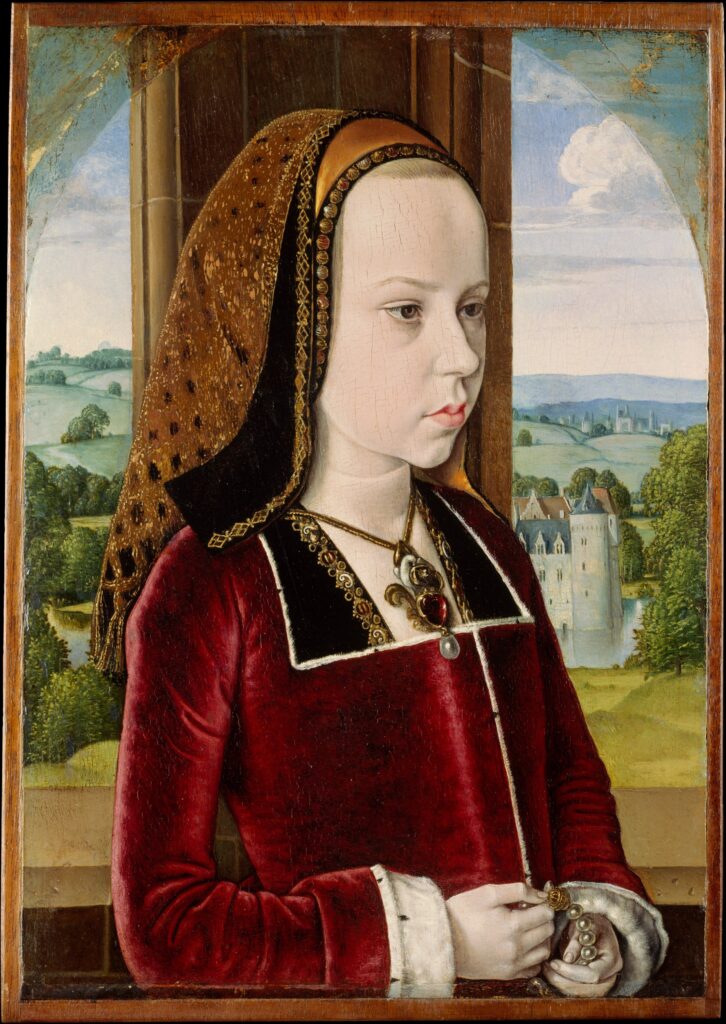
Jean Hey, Portrait of Margaret of Austria, c. 1490, Metropolitan Museum of Art, New York City, NY, USA.
Margaret was born the only daughter of Maximilian I, emperor of the Holy Roman Empire, and Mary of Burgundy at the interface between the Middle Ages and the Renaissance. Her high status as a member of the Habsburgs, a rising dynasty in Europe, made her one of the most sought-after royal brides. She was successively married to the Spanish Crown Prince Juan and Duke Philibert II of Savoy, whose premature deaths left Margaret a childless widow at the young age of 24.
Her father then appointed her Governor of the Habsburg Netherlands, a region encompassing the modern Benelux countries. An intelligent and politically apt woman, Margaret’s regency brought economic prosperity and political stability. Maximilian also entrusted her with the upbringing of her nephew, future Emperor Charles V. Charles appreciated his aunt’s competence in government and sent her on several significant missions that would earn her the moniker of Europe’s greatest diplomat. Margaret also acquired a reputation as one of the most distinguished patrons of the arts in Northern Europe, collecting splendid pieces such as Jan van Eyck’s legendary Arnolfini portrait. Among the many works she owned, her portraits are the most pivotal to promoting her rank and that of her house.
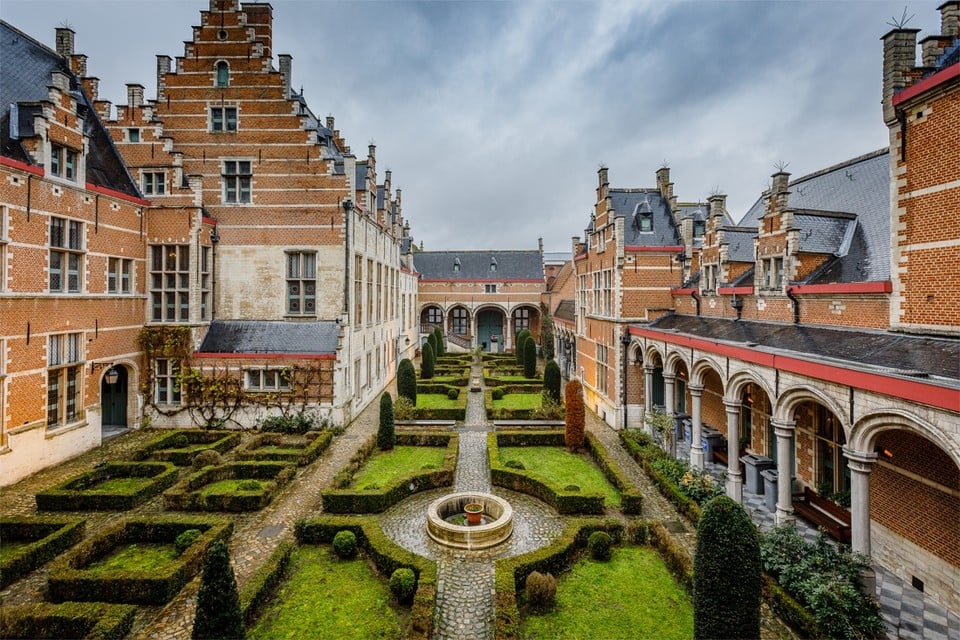
Court of Savoy, early 16th century, Mechelen, Belgium. © Dirk Vertommen.
Margaret took up residence in Mechelen, a city situated between Brussels and Antwerp. The name of her palace, the Court of Savoy, demonstrates the strong bond with her second husband Philibert, which became core to her identity in portraiture. As was common practice at courts, Margaret had the main assembly room hung with portrait paintings of her ancestors, living relatives, and foreign princes.
While a modern viewer might feel uncomfortable being observed by many a painted face, Margaret’s contemporaries would have been awestruck by an aura of dynastic leadership. If you were looking for a portrait of the regent herself, however, you would have been disappointed. Margaret had her portraits exhibited in other parts of the palace, perhaps to not imply equal rank with ruling monarchs. As governor, she only acted in service of her father and nephew respectively. And “female humbleness” was required after all. One of the rooms to feature her portrait was the library, where Margaret had paintings, sculptures, and numerous other objects displayed. Among the most precious works were two marble busts of her and Philibert. Unfortunately, these sculptures are now lost but can be linked to two existing small-scale busts of boxwood, which resemble the marble portraits’ description from the inventory.
The miniature busts were made by Conrad Meit (1480s–1550/51), a German sculptor of the Late Gothic tradition who served as one of Margaret’s court artists. They show the couple in contemporary courtly garments on a pedestal, keeping a straight face that radiates aristocratic aloofness. Meit accounts for the big trend in the Renaissance to have one’s portrait executed in the classical fashion of a bust. Due to the small scale, it is possible that they functioned as a model for the more precious marble busts, but were kept because of their artistic value.
Margaret’s library was a representative room open to courtiers and diplomats. Hence, her portraits needed to identify her unmistakably as the rightful regent of the Habsburg Netherlands. The wooden bust features one significant detail to do so. The heart-shaped hood Margaret wore was a typical headdress for women of the Low Countries around 1500. This is illustrated, for instance, in a portrait by Antwerp painter Joos van Cleve.
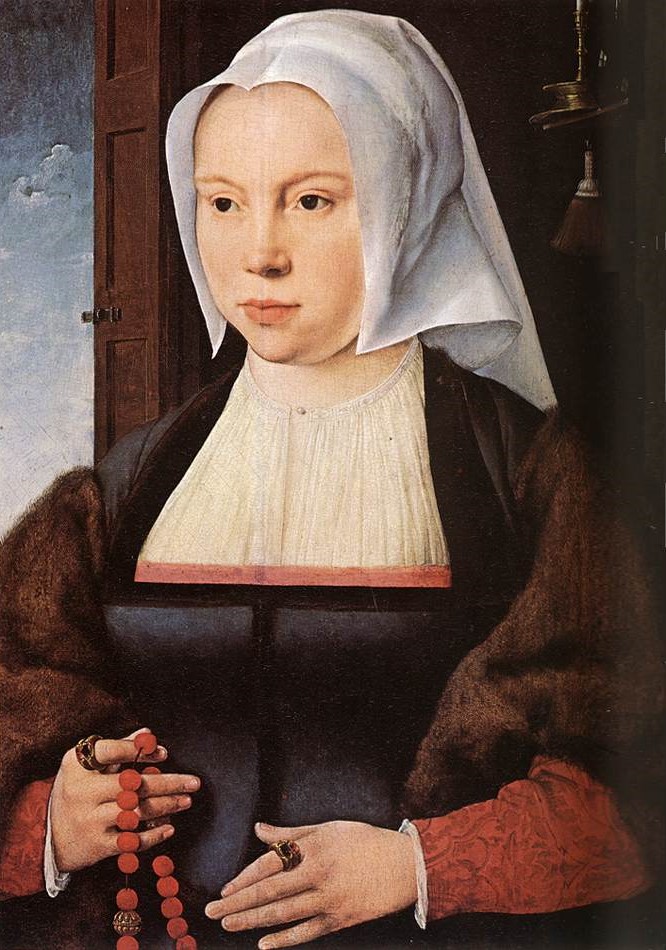
Joos van Cleve, Portrait of a Woman, 1520–1527, Uffizi, Florence, Italy. Detail.
This seems particularly plausible when considering that the Low Countries were actually the dominions of her mother, Mary of Burgundy. They only fell under Habsburg rule through Mary’s marriage to Maximilian. The emperor never managed to gain the favor of his new subjects, who frequently rebelled against him. Margaret therefore cleverly staged herself as a legitimate heiress of her mother through national costume. She had this visual strategy incorporated into several portraits, such as a painting by Bernard van Orley as well as another wooden bust and a terracotta medal by Meit.
These three examples include another clothing element to generate a specific type of public image. The pleated white ruff covering her décolleté was a sign of widowhood, bringing us right to the never-ending story: women’s tie to men.
Margaret’s short-lived marriage to Philibert was described as very happy, which explains her steadfast rejection of her father’s plans for new matches. An inclination to remain autonomous from a husband’s supremacy may have fueled her determination. Whatever the reasons for this decision, Margaret still wished to be identified as Philibert’s wife beyond his death, be she as consort or widow. The boxwood miniatures that cast her as consort, for example, were carved a decade after Philibert’s passing. In painting, she obviously preferred to convey the status of a widow.
Her court painter Bernard van Orley (c. 1490–1541/1542) created one type that functioned as her official state portrait and was reproduced in multiple replicas. They were given as a gift to foreign princes, relatives, or courtiers and were likely hung in similar public spaces such as Margaret’s portrait gallery in the Court of Savoy. Beside the pleated ruff, the black dress highlights her role as a widow, while the ermine trimming at the sleeves represents royalty. Some modern patriarchs might romanticize Margaret’s insistence on her marital identity as a sign of love worthy of an old-school Disney princess.
As is so often the case, the reality is far more complex. Despite her undoubted love for Philibert, Margaret only followed the principles early modern society had up its sleeves for married women. They were supposed to perpetually mourn their deceased husband to retain his memory. As the same was not required the other way around, women’s subordination to men was once again established. Regarding portraiture, a look at some of Margaret’s female colleagues confirms the convention of public widowhood.
Caterina Sforza (1463–1509), regent for her minor son’s principalities of Imola and Forli, was considered one of the most powerful women in Italy. In a medal produced shortly after her husband’s death, she wears the veil of Italian widows to demonstrate where her political mandate came from. Jumping to another throne, Margaret’s sister-in-law Louise of Savoy (1476–1531) had political influence over her son, Francis I of France. Her portrait painting also unequivocally represents her as a widow. It is evident that women of the nobility were expected to stress their conjugal “duties” in imagery, even more so after their husbands’ deaths.
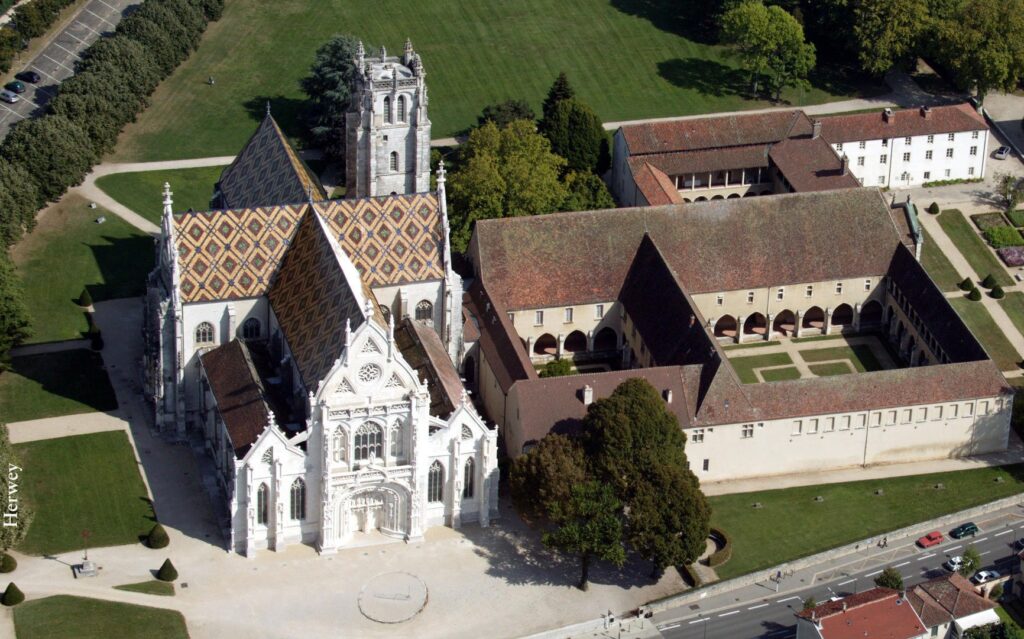
The Royal Monastery of Brou, early 16th century, Bourg-en-Bresse, France. © Herwey Ville Bourg-en-Bresse
There was one last chance for Margaret to appear more regal and authoritative. Her funerary complex at the Royal Monastery of Brou in Bourg-en-Bresse represents her far more majestically than any previous pictures. Built on her behalf, the monastery and adjacent church were located in the duchy of her husband (today part of France). The choir houses the tombs of Margaret, Philibert, and her mother-in-law: an unmistakable statement about where Margaret believed her place to be. Meit created debatably his most magnificent work with the burial monuments of the family, a supreme Gothic extravaganza of tracery and allegories.
The three graves are separated, with Philibert as the patriarch in the center, of course. To his left stands Margaret’s sarcophagus, while his mother appears to the right. The spatial attention may be on Philibert, yet Margaret undoubtedly wins the match of who is the real eye-catcher; her tomb not only outshines that of her husband in sheer size, it is also crowned by a huge canopy that gives the viewer a feast for the eyes.
The sculpture depicting Margaret crowns her with the archducal hat of Austria, her paternal heritage, and dresses her in a splendid gown that is lavishly trimmed with ermine. None of her previous portraits conjure such an air of royal dignity and power!
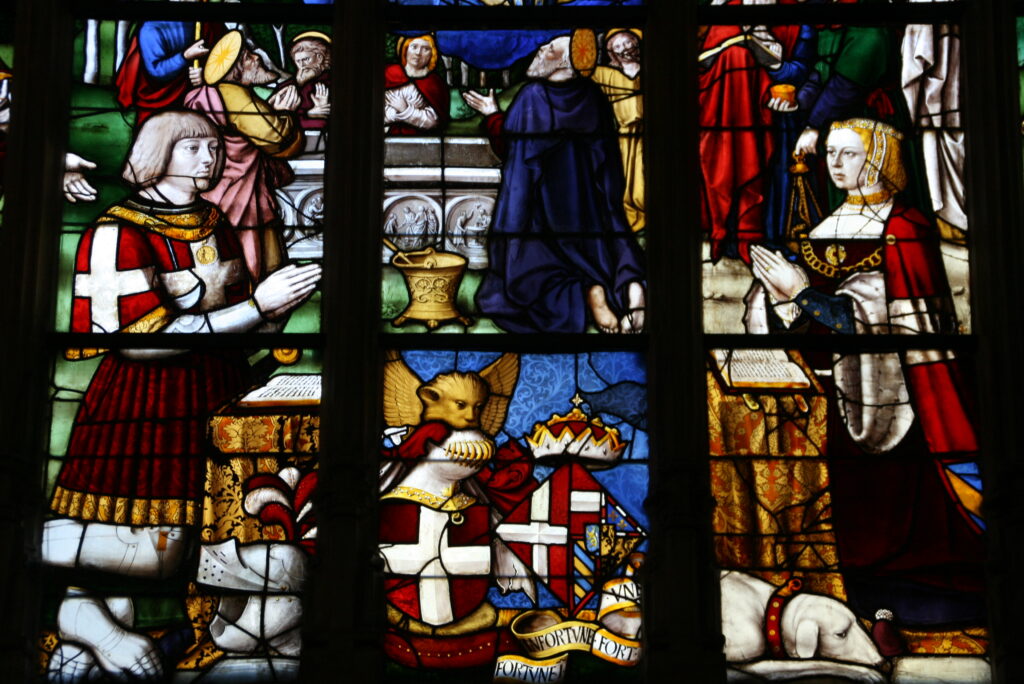
Antoine Noisin and Jean Branchon, Philibert II and Margaret of Austria in Prayer, 1525–27, Royal Monastery of Brou, Bourg-en-Bresse, France. Photo by Harrie Gielen.
A representation in a stained glass window in the church echoes Meit’s grand sculpture. Opposite Philibert, Margaret kneels in prayer in a sumptuous courtly garment with a coronet that radiates downright majesty. Apparently, Margaret saw death as the one chance to establish herself to posterity as what she truly was: a powerful and successful stateswoman. And yet, even here, some details allude to her and Philibert’s happy union. On the chest of her sculpture, hidden from our sight, lies a chain with a pendant that features Philibert’s portrait. And there, the heads of both sculptures look at each other. Love conquers all, after all.
DailyArt Magazine needs your support. Every contribution, however big or small, is very valuable for our future. Thanks to it, we will be able to sustain and grow the Magazine. Thank you for your help!